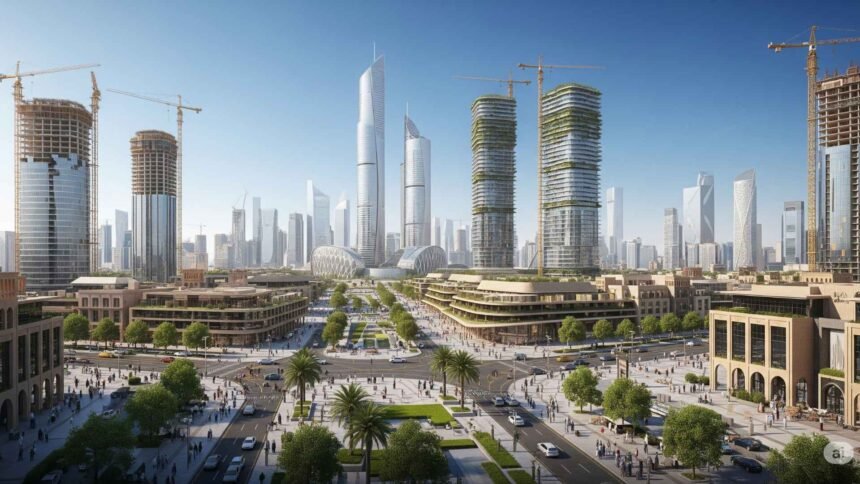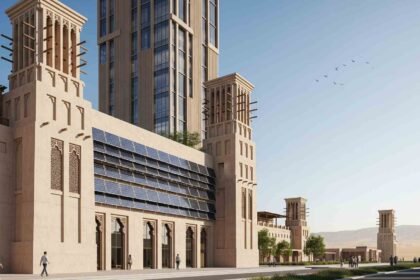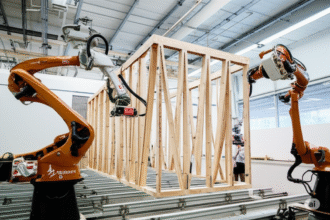Saudi Arabia’s Vision 2030, launched in 2016 by Crown Prince Mohammed bin Salman, is a transformative economic and social blueprint aimed at reducing the kingdom’s dependence on oil and diversifying its economy. At the heart of this ambitious plan lies the construction sector, which has emerged as a key driver of economic growth, innovation, and sustainability.
Unprecedented Growth and Demand
Vision 2030 has injected new life into Saudi Arabia’s construction sector, driving unprecedented growth and demand. According to recent reports, the sector is expected to reach a market size of $91 billion by 2030, growing at an annual rate of 5.37%. This growth is fueled by substantial government investments in infrastructure and “Giga Projects” such as NEOM and The Red Sea Project, which aim to promote economic diversification, technological advancement, and sustainability.
The scale of the construction boom is staggering. Contracts awarded in the sector grew from $11.2 billion in 2016 to $14.6 billion in 2018, with planned and unawarded projects worth over $825 billion. As of 2025, Saudi Arabia has more than 25 giga projects in various stages of construction, planning, and design, collectively representing trillions of riyals. These figures underscore the sector’s pivotal role in achieving Vision 2030’s goals.
| Metric | Details |
| Market Size by 2030 | $91 billion, with 5.37% annual growth rate |
| Contracts Awarded (2016-2018) | Increased from $11.2 billion to $14.6 billion |
| Planned/Unawarded Projects | Over $825 billion |
| Giga Projects in 2025 | More than 25 projects, worth trillions of riyals |
Mega-Projects Defining the Future
Vision 2030 has introduced a series of mega-projects that are transforming the physical landscape of Saudi Arabia and positioning the kingdom as a global leader in urban development. Among the most notable are:
- NEOM: A $500 billion smart city project, NEOM is envisioned as a hub for innovation, sustainability, and technology. It includes The Line, a 170-km linear city designed to house 9 million people with zero cars, roads, or carbon emissions.
- The Red Sea: A $50 billion luxury tourism destination, this project features 50 resorts spread across 22 islands, aiming to attract high-end tourists while preserving the natural environment.
- Qiddiya Entertainment City: A $20 billion entertainment and sports hub near Riyadh, Qiddiya will include theme parks, sports arenas, and cultural venues.
- King Abdullah Economic City: With an investment of $67 billion, this city is designed to be a major industrial and logistics hub.
- Jeddah Tower: At $2 billion, this skyscraper is set to become the world’s tallest building, surpassing Dubai’s Burj Khalifa.
These projects are attracting international construction firms, with the government offering incentives to encourage foreign investment. The legal framework, which combines Shari’ah principles with international standards like FIDIC contracts, ensures transparency and fairness, making Saudi Arabia an attractive destination for global players.
| Project | Investment | Description |
| NEOM | $500 billion | Smart city with The Line, a zero-carbon linear city |
| The Red Sea | $50 billion | Luxury tourism destination with 50 resorts across 22 islands |
| Qiddiya Entertainment City | $20 billion | Entertainment and sports hub with theme parks and cultural venues |
| King Abdullah Economic City | $67 billion | Industrial and logistics hub |
| Jeddah Tower | $2 billion | World’s tallest skyscraper |
Sector-Specific Transformations
Vision 2030’s impact extends across multiple sectors, all of which rely heavily on construction:
- Hospitality: To meet the goal of attracting 1.5 million leisure tourists by 2020, Saudi Arabia has planned 172 hotel projects, contributing to over 69,000 rooms under development. By 2025, the kingdom has the largest pipeline of hotel rooms in the region, with approximately 210 projects aiming to deliver over 69,000 rooms.
- Healthcare: The government has allocated SAR 147 billion for health services expansion, with SAR 33 billion dedicated to Vision 2030 initiatives. This includes 36 new hospitals and two medical cities, adding 8,950 and 2,350 beds, respectively.
- Transportation: Key projects include the $22.5 billion Riyadh Metro and an $8 billion expansion of rail services, improving connectivity and mobility.
- Renewable Energy: Vision 2030 emphasizes sustainable development, with construction playing a crucial role in building renewable energy infrastructure to reduce carbon emissions.
- Residential: Residential projects are targeting the construction of 300,000 new units by 2025, addressing the housing needs of the growing population.
| Sector | Investment/Target | Key Projects |
| Hospitality | 210 projects, 69,000 rooms | 172 hotel projects |
| Healthcare | SAR 147 billion, 36 hospitals, 2 cities | 8,950 hospital beds, 2,350 medical city beds |
| Transportation | $22.5 billion (Riyadh Metro), $8 billion | Riyadh Metro, rail expansion |
| Residential | 300,000 new units by 2025 | Sakani housing program |
Embracing Technology and Sustainability
The construction sector in Saudi Arabia is at the forefront of technological innovation and sustainability. The PropTech market is growing, with startups receiving seed funding to develop solutions in AI, robotics, and 3D printing. These technologies are being integrated into construction processes to improve efficiency, reduce costs, and enhance quality.
Sustainability is a core pillar of Vision 2030. The Mostadam Standard, introduced in 2019, sets guidelines for green buildings, focusing on reducing energy usage and CO2 emissions. Construction companies are increasingly adopting prefabricated techniques and 3D printing to minimize environmental impact. Recent initiatives aim to reduce lifecycle emissions by 50-60%, aligning with global sustainability goals.
Challenges and Opportunities
While Vision 2030 presents immense opportunities, it also poses challenges for the construction sector. Managing the scale and complexity of mega-projects requires advanced project management skills and significant resources. Additionally, ensuring the integration of the local workforce and transferring knowledge to Saudi nationals remains a priority for long-term sustainability.
However, these challenges also create opportunities. The influx of foreign investment and technology transfer is enhancing the skills and capabilities of the local construction industry. Moreover, the focus on sustainability and innovation is positioning Saudi Arabia as a leader in modern construction practices. The government’s commitment to increasing the private sector’s GDP contribution from 40% to 65% by 2030 through public-private partnerships and privatization further opens doors for collaboration and growth.
Recent Developments in 2025
As of 2025, Saudi Arabia continues to make significant progress toward its Vision 2030 goals, with the construction sector remaining a key driver. Recent reports indicate that the construction industry is expected to reach $91 billion by 2030, driven by ongoing and planned projects. There are currently more than 25 giga projects in various stages of construction, planning, and design, collectively worth trillions of riyals.
Notable among these are the 24 transformative mega and giga-projects shaping the kingdom’s future. Residential projects are targeting 300,000 new units by 2025, while sustainability initiatives aim to reduce lifecycle emissions by 50-60%. Smart construction technologies are also on the rise, driven by Vision 2030’s emphasis on innovation and sustainability.
The government has committed nearly US$1 trillion to infrastructure development by 2030, enhancing road, aviation, maritime, and rail networks to improve connectivity and support economic growth. These developments underscore the construction sector’s continued importance in achieving Vision 2030 objectives.
Future Outlook
With five years left until 2030, the construction sector in Saudi Arabia is poised for continued growth and transformation. The ongoing and planned projects will not only reshape the kingdom’s physical landscape but also drive economic diversification and create employment opportunities. The integration of advanced technologies and sustainability practices will further enhance the sector’s competitiveness on the global stage.
As Saudi Arabia progresses toward its Vision 2030 goals, the construction sector will remain a pivotal driver of change, shaping the future of the kingdom and setting new benchmarks for the industry worldwide.







